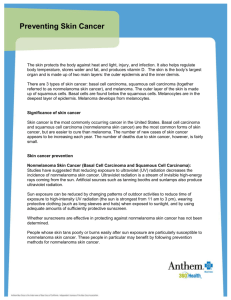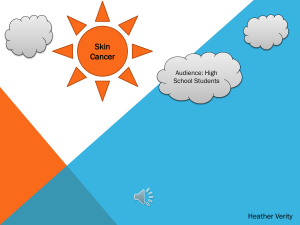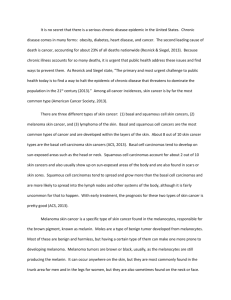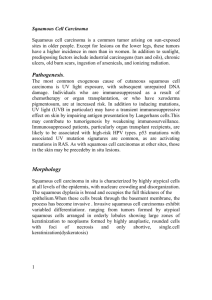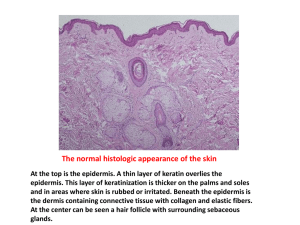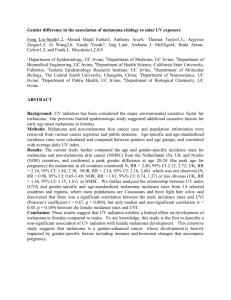Types of skin cancer
advertisement
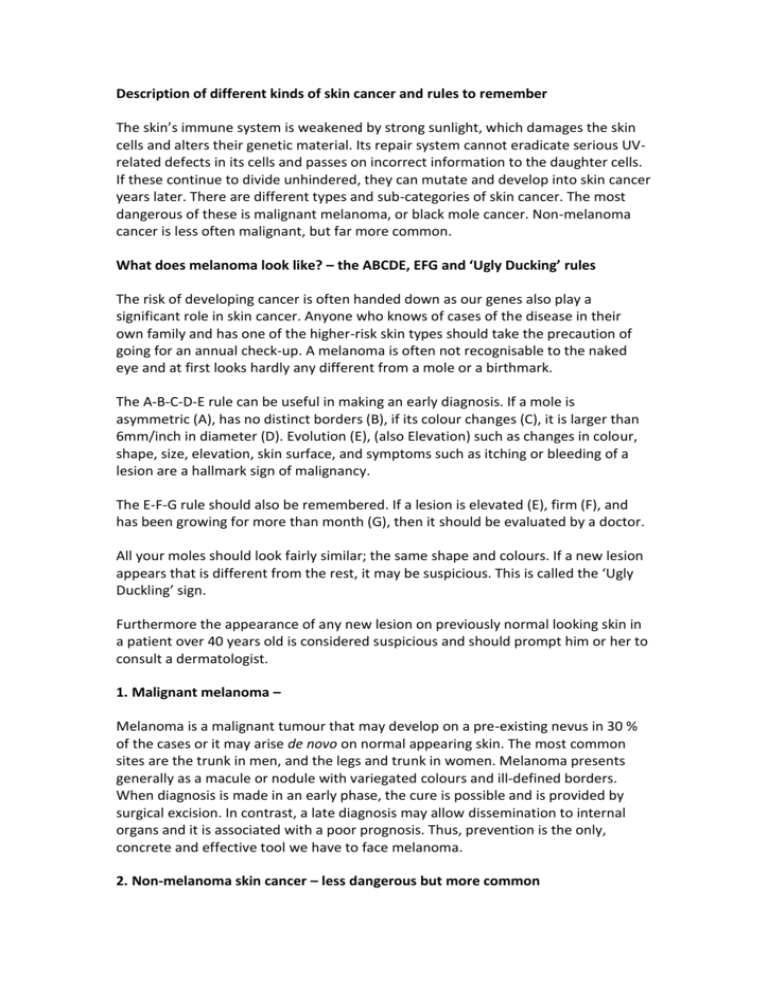
Description of different kinds of skin cancer and rules to remember The skin’s immune system is weakened by strong sunlight, which damages the skin cells and alters their genetic material. Its repair system cannot eradicate serious UVrelated defects in its cells and passes on incorrect information to the daughter cells. If these continue to divide unhindered, they can mutate and develop into skin cancer years later. There are different types and sub-categories of skin cancer. The most dangerous of these is malignant melanoma, or black mole cancer. Non-melanoma cancer is less often malignant, but far more common. What does melanoma look like? – the ABCDE, EFG and ‘Ugly Ducking’ rules The risk of developing cancer is often handed down as our genes also play a significant role in skin cancer. Anyone who knows of cases of the disease in their own family and has one of the higher-risk skin types should take the precaution of going for an annual check-up. A melanoma is often not recognisable to the naked eye and at first looks hardly any different from a mole or a birthmark. The A-B-C-D-E rule can be useful in making an early diagnosis. If a mole is asymmetric (A), has no distinct borders (B), if its colour changes (C), it is larger than 6mm/inch in diameter (D). Evolution (E), (also Elevation) such as changes in colour, shape, size, elevation, skin surface, and symptoms such as itching or bleeding of a lesion are a hallmark sign of malignancy. The E-F-G rule should also be remembered. If a lesion is elevated (E), firm (F), and has been growing for more than month (G), then it should be evaluated by a doctor. All your moles should look fairly similar; the same shape and colours. If a new lesion appears that is different from the rest, it may be suspicious. This is called the ‘Ugly Duckling’ sign. Furthermore the appearance of any new lesion on previously normal looking skin in a patient over 40 years old is considered suspicious and should prompt him or her to consult a dermatologist. 1. Malignant melanoma – Melanoma is a malignant tumour that may develop on a pre-existing nevus in 30 % of the cases or it may arise de novo on normal appearing skin. The most common sites are the trunk in men, and the legs and trunk in women. Melanoma presents generally as a macule or nodule with variegated colours and ill-defined borders. When diagnosis is made in an early phase, the cure is possible and is provided by surgical excision. In contrast, a late diagnosis may allow dissemination to internal organs and it is associated with a poor prognosis. Thus, prevention is the only, concrete and effective tool we have to face melanoma. 2. Non-melanoma skin cancer – less dangerous but more common Non-melanoma skin cancers are not as dangerous as melanoma but they are by far the most common skin tumours in white people. Preferential sites of involvement are the sun-exposed areas. These include the face, ears, and backs of the hands and arms and, in men, bald patches. If diagnosed early on, there is a very good chance of curing the slow-growing non-melanoma skin cancer. Although metastases seldom occur with non-melanoma skin cancer, doctors do advise regular visits to a specialist to check for changes in the skin. Non-melanoma skin cancer is classed in three different types: a) Basal cell carcinoma Basal cell carcinoma manifests itself as a thin, coloured patch of skin with a shiny surface that, like actinic keratoses, occurs particularly on the face on the so-called “sun terraces”. BCC may also be a nodule that in time ulcerates and bleeds with a crust formation, and slowly progresses over months and years. Basal cell carcinoma, which originates in the lowest layer of the epidermis, often grow (enlarges) for years without causing any discomfort. If left untreated, however, the cancer grows deeper down into the tissue where it destroys underlying structures. Although BCC metastasizes very rarely, it may destroy the adjacent and underlying tissues causing major discomfort. b) Actinic keratoses Actinic keratoses present as ill-defined macule or plaques with colour varying from pink to red to brown. They have a rough surface and this is why at the initial phase they can be better recognized by palpation rather than by visual inspection. They typically develop on sun-damaged skin of elderly subjects and are caused by inability of the skin’s local immune system to repair the cell damage triggered by prolonged UV radiation. This early form of premalignant non-melanoma skin cancer is the basis on which 10 to 15 per cent of invasive squamous cell cancer develops. c) Squamous cell cancer Squamous cell cancer, or squamous cell carcinoma, often originates in actinic keratoses and may resemble basal cell carcinoma. However, the surface is usually more elevated and crusty. It presents as an ulcerated lesion, with thick borders, which do not heal. Preferential sites are the lower lip and ears. Squamous cell carcinomas may spread to lymph nodes and other organs (metastasis). Contributor: Prof Ketty Peris, ketty.peris@univaq.it



